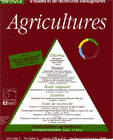Gestion de la fertilité et évolution des sols de Gakudi (Maradi, Niger)
Résumé
Gakudi village farmers distinguish three major distinct soil types: jigawa, geza and hako. Soil texture, reactions to precipitation and runoff, and workability with agricultural tools, are the local soil classification indicators. Soils became differentiated due to the impact of the hydrological network on their geochemical composition during the Quaternary period. Jigawa soils have a clear topsoil layer, and they are permeable and easy to work with tools. Geza soils are a deeper red and rapidly waterlogged during rainstorms. Hako soils are compact, impermeable, quite hard when dry, and difficult to work. Farmers preferentially settled in jigawa areas as these soils can be easily cultivated with traditional agricultural tools. However, given the population growth with the arrival of many new migrants, jigawa areas were rapidly saturated. Geza lands were therefore subsequently cultivated, which led to a decline in fertility and crop yields, and changes in topsoil colour, the abundance and vitality of specific wild and cultivated plants, along with the appearance and extension of hako soils. In order to address this phenomenon, farmers have developed soil fertility management practices compatible with their modest technical potential and resources in the region. These techniques include conservation of soil organic matter, fallows, improved land clearing, and subsidiary use of mineral fertilizers. Farmers now consider that hako soils have been transformed into jigawa soils on their lands under the combined effects of human actions, rain and wind, which have modified the physical and chemical characteristics of the upper hako soil layer, creating jigawa-like conditions. Working the topsoil layer and mulching barren areas are mainly responsible for the rapid convergence in the appearance of cultivated hako and jigawa topsoils.Téléchargements
Publié
1998-09-01
Comment citer
Ambouta, K. J.-M. ., Amadou, I., & Souley, I. (1998). Gestion de la fertilité et évolution des sols de Gakudi (Maradi, Niger). Cahiers Agricultures, 7(5), 395–400 (1). Consulté à l’adresse https://revues.cirad.fr/index.php/cahiers-agricultures/article/view/30115
Numéro
Rubrique
Articles

